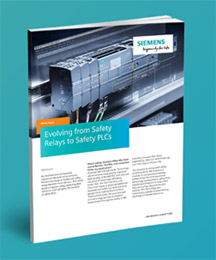Despite guaranteed and measurable lifecycle savings, manufacturers sometimes hesitate to invest in safety PLCs, which dramatically speed up troubleshooting - reducing downtime.
Choosing the right solution can be as complicated as it is crucial, so an interactive guide has been created to help you determine if you need to consider evolving to safety PLCs...
This INTERACTIVE WHITEPAPER on Selecting the Optimum Safety Solution for the Machine compares single-function and multi-function safety relays to safety PLCs to help you determine the best solution for your application.
The guide explains that single-function safety relays do offer a low-cost solution in limited applications involving a limited number of functions/devices, such as:
- stopping movement in a controlled and safe manner.
- monitoring the position of movable guards.
- interrupting a closing movement during access.
- emergency off/stop.
However, it also addresses the typical shortcomings of single-function safety relays, which include:
- difficulty troubleshooting due to complex wiring between each device.
- the significant amount of engineering required for system modifications or upgrades.
- the inability to operate in mixed modes (safety and standard).
- the tediousness of functionality changes because of each relay's defined purpose.
- the need for additional safety relays for additional safety functionality.
The guide describes how multi-functional relays can control between two to three safety functions and typically offer a smaller footprint and reduced, simplified wiring - depending on the safety functionality required. They come in a number of styles and configurations. Typical applications include:
-
A simple base unit can handle a variety of inputs.
-
Most require no software for configuration or operation. Typical setup and maintenance is simple (but with no flexibility).
-
Multi-function safety relays are often a choice when single-function relays can’t meet the safety functionality.
The typical shortcomings addressed by the guide, include:
- The cost and complexity of hard-wiring control devices.
- The difficulty involved in expanding or modifying the control system.
- The time-consuming processes involved in troubleshooting faults.
- The limited safety logic due to predefined safety relay functionality.
The guide explains how safety PLCs address the need to monitor a much larger number of input and output (I/O) points for today's increasingly complex machine tools, automation systems, and process facilities.
As the guide points out, safety PLCs offer important advantages:
- MEETS SAFETY STANDARDS - These PLCs meet the required safety standards, able to achieve up to PL e as per ISO 13849-1 or SIL 3 as per IEC 61508.
- PROGRAMMABLE - Safety-functionality changes can be easily done via programming rather than device replacement and related rewiring.
- SAFETY-FUNCTION LIBRARIES - TÜV-certified, safety-function libraries are available, significantly reducing the design time and increasing flexibility.
CHECK OUT THE FULL INTERACTIVE GUIDE |
THE INTERACTIVE GUIDE WILL ALSO INTRODUCE YOU TO
RESOURCES TO HELP YOU DELVE DEEPER AND MAKE AN INFORMED DECISION
-
Case Study: Siemens Integrator Helps Small Town Modernize Water Supply While Cutting Costs.
-
White Paper: Safe automation with SIMATIC S7-1200
-
Webinar: Four Ways to Turn a Basic Controller into an Automation Dymamo (slides)


 RELATED ARTICLE + RESOURCES
RELATED ARTICLE + RESOURCES
